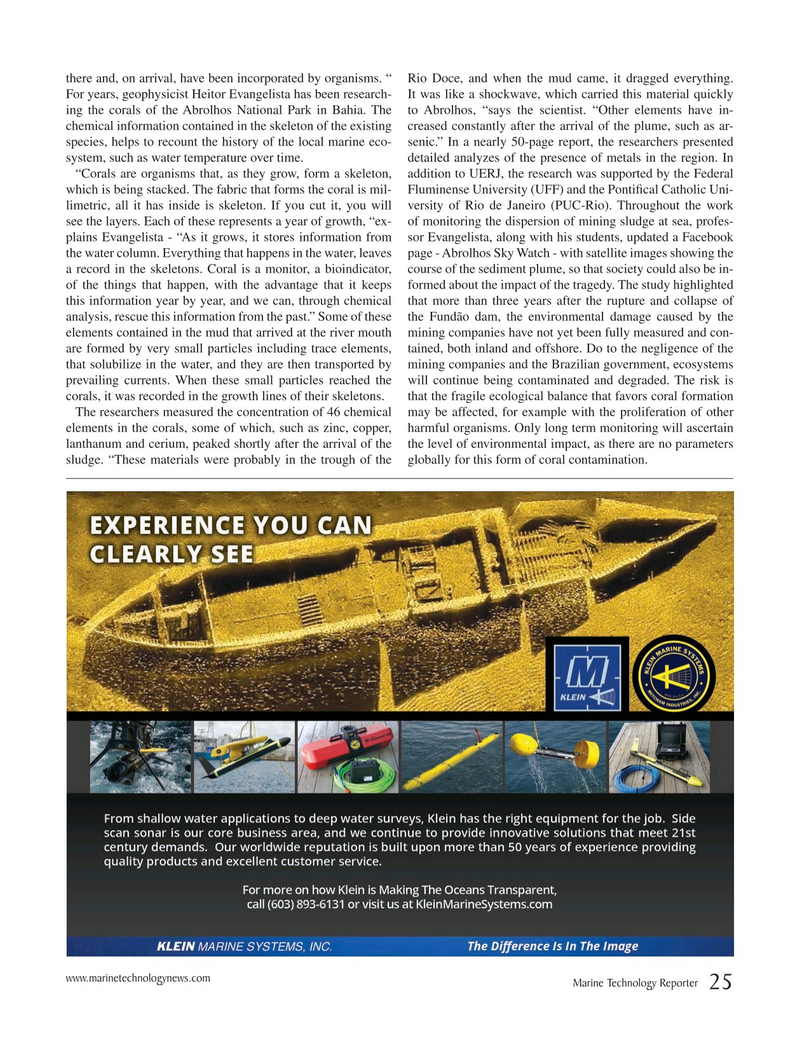
Page 25: of Marine Technology Magazine (March 2019)
Oceanographic Instrumentation: Measurement, Process & Analysis
Read this page in Pdf, Flash or Html5 edition of March 2019 Marine Technology Magazine
there and, on arrival, have been incorporated by organisms. “ Rio Doce, and when the mud came, it dragged everything.
For years, geophysicist Heitor Evangelista has been research- It was like a shockwave, which carried this material quickly ing the corals of the Abrolhos National Park in Bahia. The to Abrolhos, “says the scientist. “Other elements have in- chemical information contained in the skeleton of the existing creased constantly after the arrival of the plume, such as ar- species, helps to recount the history of the local marine eco- senic.” In a nearly 50-page report, the researchers presented system, such as water temperature over time. detailed analyzes of the presence of metals in the region. In “Corals are organisms that, as they grow, form a skeleton, addition to UERJ, the research was supported by the Federal which is being stacked. The fabric that forms the coral is mil- Fluminense University (UFF) and the Ponti? cal Catholic Uni- limetric, all it has inside is skeleton. If you cut it, you will versity of Rio de Janeiro (PUC-Rio). Throughout the work see the layers. Each of these represents a year of growth, “ex- of monitoring the dispersion of mining sludge at sea, profes- plains Evangelista - “As it grows, it stores information from sor Evangelista, along with his students, updated a Facebook the water column. Everything that happens in the water, leaves page - Abrolhos Sky Watch - with satellite images showing the a record in the skeletons. Coral is a monitor, a bioindicator, course of the sediment plume, so that society could also be in- of the things that happen, with the advantage that it keeps formed about the impact of the tragedy. The study highlighted this information year by year, and we can, through chemical that more than three years after the rupture and collapse of analysis, rescue this information from the past.” Some of these the Fundão dam, the environmental damage caused by the elements contained in the mud that arrived at the river mouth mining companies have not yet been fully measured and con- are formed by very small particles including trace elements, tained, both inland and offshore. Do to the negligence of the that solubilize in the water, and they are then transported by mining companies and the Brazilian government, ecosystems prevailing currents. When these small particles reached the will continue being contaminated and degraded. The risk is corals, it was recorded in the growth lines of their skeletons. that the fragile ecological balance that favors coral formation
The researchers measured the concentration of 46 chemical may be affected, for example with the proliferation of other elements in the corals, some of which, such as zinc, copper, harmful organisms. Only long term monitoring will ascertain lanthanum and cerium, peaked shortly after the arrival of the the level of environmental impact, as there are no parameters sludge. “These materials were probably in the trough of the globally for this form of coral contamination.
www.marinetechnologynews.com
Marine Technology Reporter 25
MTR #2 (18-33).indd 25 3/11/2019 11:06:47 AM

 24
24

 26
26
